உதுமானியப் பேரரசு
உதுமானியப் பேரரசு Ottoman Empire Osmanlı İmparatorluğu دولت عالیه عثمانیه Devlet-i Âliye-yi Osmâniyye | |||||||||||
|---|---|---|---|---|---|---|---|---|---|---|---|
| 1299–1922 | |||||||||||
| 'குறிக்கோள்: 'دولت ابد مدت Devlet-i Ebed-müddet ("The Eternal State") | |||||||||||
 1683 இல் எல்லைகள் | |||||||||||
| நிலை | பேரரசு | ||||||||||
| தலைநகரம் | சோகூட் (1299–1326) பூர்சா (1326–65) எடையர்ன் (1365–1453) இஸ்தான்புல் (1453–1922) | ||||||||||
| அரசாங்கம் | மன்னராட்சி | ||||||||||
| சுல்தான்கள் | |||||||||||
• 1281–1326 | முதலாம் உதுமான் | ||||||||||
• 1918–22 | ஆறாம் முகம்மது | ||||||||||
| Grand Viziers | |||||||||||
• 1320–31 | அலாவுத்தீன் பாசா | ||||||||||
• 1920–22 | அஹ்மத் தவ்ஃபீக் பாசா | ||||||||||
| வரலாறு | |||||||||||
• அமைப்பு | 1299 | ||||||||||
• Interregnum | 1402–1413 | ||||||||||
• 1. அரசியலமைப்பு | 1876-1878 | ||||||||||
• 2. அரசியலமைப்பு | 1908-1918 | ||||||||||
• பிரிவு | நவம்பர் 17 1922 | ||||||||||
| பரப்பு | |||||||||||
| 1680 | 5,500,000 km2 (2,100,000 sq mi) | ||||||||||
| மக்கள் தொகை | |||||||||||
• 1856 | 35350000 | ||||||||||
• 1906 | 20884000 | ||||||||||
• 1914 | 18520000 | ||||||||||
• 1919 | 14629000 | ||||||||||
| நாணயம் | அக்சே, குரூஸ், லீரா | ||||||||||
| |||||||||||
உதுமானியப் பேரரசு (ஒத்தமான் பேரரசு, Ottoman Empire, 1299–1922, துருக்கி: Osmanlı Devleti 'உஸ்மான்லி தவ்லத்தி' அல்லது Osmanlı İmparatorluğu) என்பது துருக்கியர்களால் ஆளப்பட்ட ஒரு பேரரசு ஆகும்.
இது துருக்கியப் பேரரசு எனவும் அழைக்கப்பட்டது. இப்பேரரசு கி.பி. 1299ஆம் ஆண்டு துருக்கிய வம்சத்தைச் சேர்ந்த உஸ்மான் பே என்பவரின் தலைமையின் கீழ் வடமேற்கு அனத்தோலியாவில் உருவாக்கப்பட்டது. சுல்தான் இரண்டாம் முஹம்மதால் கி. பி. 1453 இல் கைப்பற்றப்பட்ட பின்னர் ஒத்தமான் இராச்சியம், பேரரசாக மாற்றப்பட்டது.[1][2][3]
இப்பேரரசு உச்ச கட்டத்தில் இருந்த போது (16ஆம் – 17ஆம் நூற்றாண்டுகளில்) இப்பேரரசின் ஆட்சி தென்கிழக்கு ஐரோப்பா, மத்திய கிழக்கு, வட ஆபிரிக்கா என மூன்று கண்டங்களில் மேற்கே ஜிப்ரால்ட்டர் நீரிணை முதல் கிழக்கே காசுப்பியன் கடல், பாரசீக வளைகுடா, ஆஸ்திரியா, சிலோவாக்கியா, உக்குரைன் பல பகுதிகள், சூடான், எரித்திரியா, தெற்கே சோமாலியா மற்றும் யமன் வரை பரவியிருந்தது. உதுமானியப் பேரரசு மொத்தம் 29 மாகாணங்களைக் கொண்டிருந்தது.
பெயர்[தொகு]
உதுமானிய துருக்கிய மொழியில் பேரரசு என்பது தவ்லத் ஏ ஆலிய்யிஏ உஸ்மானிய்யி (دَوْلَتِ عَلِيّه عُثمَانِیّه) அல்லது உஸ்மான்லி தவ்லத்தீ (عثمانلى دولتى) என்ற பதத்தால் குறிப்பிடப்படுகின்றது.நவீன துருக்கி மொழியில் இது 'Osmanlı Devleti அல்லது Osmanlı İmparatorluğu' என்பதால் அறியப்படுகின்றது. சில மேற்கத்திய பதிவுகளில் இது "ஒத்தமான்" மற்றும் "துருக்கி" என்ற இரு பெயர்களில் பயன்படுத்தப்பட்டுள்ளது. இரட்டையாக எழுதும் இம்முறை 1920-1923 காலப்பகுதயில்,அங்காரா நகரை தளமாகக் கொண்டு உருவாக்கப்பட்ட துருக்கியில் முடிவுக்கு கொண்டுவரப்பட்டதுடன் அன்றிலிருந்து துருக்கி(Turkey) என்ற தனித்த சொல் அதிகாரப்பூர்வமாக பயன்படுத்தப்பட்டு வருகின்றது.
வரலாறு[தொகு]
எழுச்சி (1299-1453)[தொகு]
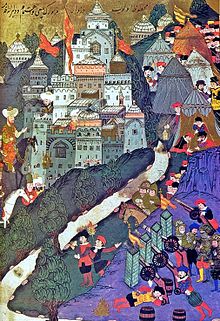
துருக்கிய செல்ஜூக்ரும் சுல்தான் ஆட்சியின் வீழ்ச்சிக்குப் பின்னர் கி.பி.1300இல் உதுமானியர்களின் முன்னோடிகள் வாழ்ந்த அனத்தோலியா பகுதி ஒரு சீரற்ற சுதந்திரப் பிரதேசமாகப் பிரிந்ததுடன் பல துருக்கிய மாநிலங்கள் காஸி குடியரசுகள் (Ghazi Emirates) என அழைக்கப்பட்டன. இதில் ஒரு காஸி குடியரசு முதலாம் உஸ்மானால் (1258[4] –1326) நிர்வகிக்கப்பட்டது. உஸ்மான் என்ற பெயரிலிருந்து ஒத்மான்ன் என்ற பெயர் பெறப்பட்டு பின்னர் அது ஒத்தமான் என அறியப்பட்டது.
முதலாம் உஸ்மான், துருக்கியக் குடியிருப்புக்களை பைசாந்தியப் பேரரசின் (Byzantine Empire) முனைப்பகுதியை நோக்கி விரிவுபடுத்தினார்.
முதலாம் உஸ்மானின் மறைவுக்குப் பின் வந்த நூற்றாண்டில் உதுமானிய ஆட்சி கிழக்கு மத்தியதரைக் கடல் மற்றும் ஃபல்கேன் வழியாக விரிவடைய ஆரம்பித்தது. உஸ்மானின் மகன் உர்ஹான் 1324இல் பூர்சா நகரைக் கைப்பற்றியதுடன் அதை உதுமானிய மாநிலத்தின் புதிய தலைநகராக மாற்றினார். அதாவது பூர்சா நகரின் வீழ்ச்சியினால் வடமேற்கு அனத்தோலியா பகுதியின் கட்டுப்பாட்டை பைசாந்தியப் பேரரசிடம் (Byzantine Empire) இழந்தது. முக்கிய நகரான தெஸ்சாலுன்கி 1387இல் வெனேடியன்ஸ்களிடம் இருந்து கைப்பற்றப்பட்டது. 1389இல் கொசோவோ உதுமானியர்களால் வெற்றிகொள்ளப்பட்டதன் மூலம் பிராந்தியத்தின் மீதான செர்பியர்களின் அதிகாரம் முடிவுக்கு கொண்டுவரப்பட்டதுடன் இது உதுமானியர்கள் ஐரோப்பாவில் தடம் பதிப்பதற்கும் காரணமாக அமைந்தது.
1396இல் நிகழ்ந்த நிகோபொலிஸ் போரில் மத்திய காலத்தின் சிலுவைப்படை எனக் கருதப்படும் பெரும் படையினரால் துருக்கிய உதுமானியர்களின் வெற்றியைத் தடுக்கமுடியவில்லை.
ஃபல்கேன் மீதான துருக்கிய ஆட்சியின் விரிவாக்கம் கான்ஸ்டண்டினோப்பிள் நகரை கைப்பற்றும் நோக்கத்திற்குக் காரணமாக அமைந்தது.
விரிவாக்கம் மற்றும் உச்சநிலை (1453–1566)[தொகு]
இரண்டாம் முராத் என்பவரின் மகனான இரண்டாம் முகம்மத் ஆடசிப் பிரதேசத்தையும் இராணுவத்தையும் மறுசீரமைத்ததுடன் 29 மே 1453 அன்று கான்ஸ்டண்டினோப்பிள் நகரைக் கைப்பற்றினார். உதுமானிய அரசாங்கத்தை ஏற்றுக் கொண்டதற்கு பரிமாற்றாக மரபுவழி கிறிஸ்தவ தேவாலயங்களை அவற்றின் நிலங்களில் தன்னாட்சியாக இயங்குவதற்கு இரண்டாம் முகம்மத் அனுமதி வழங்கினார். ஏனெனில் ஐரோப்பிய ஆட்சி மாநிலங்களுக்கும் இறுதி பைசாந்திய இராச்சியத்துக்கும் (Byzantine Empire) இடையே மோசமான உறவு நிலவிவந்தது. பெரும்பான்மையான மரபுவழி மக்கள் வெனேடியன் அரசை விடவும் விருப்பத்துடன் உதுமானிய அரசாங்கத்தை ஏற்றுக் கொண்டார்கள்.[5]
15 மற்றும் 16ஆம் நூற்றாண்டுகளில் உதுமானியப் பேரரசு ஒரு விரிவடையும் காலத்தினுள் நுழைந்தது. இக்காலப்பகுதயில் பேரரசு மிகச்சிறந்த வளர்ச்சியைக் கண்டதுடன் ஆடசிப் பொறுப்புத் திறமையுள்ள உறுதியான சுல்தான்களிடம் வந்தது. உதுமானியப் பேரரசின் கட்டுப்பாட்டுப் பகுதியின் பாதைகள் வழியாகவே ஐரோப்பா மற்றும் ஆசியா கண்டங்களுக்கு இடையிலான வியாபார நடவடிக்கைகள் மேற்கொள்ளப்பட்டது. இதனால் இந்த பேரரசு பொருளாதாரத்திலும் தழைத்தோங்கியது.[6]
சுல்தான் முதலாம் சலீம் (1512–1520) பாரசீகத்தின் சபாவித் வம்ச ஆட்சியாளர் ஷா இஸ்மாயிலை சால்டிரன் யுத்தத்தில் தோல்வியடையச் செய்து உதுமானியப் பேரரசின் கிழக்கு மற்றும் மேற்குப் பகுதிகளை விரிவுபடுத்தினார்.[7] முதலாம் சலீம் உதுமானிய அரசாங்கத்தை எகிப்தில் நிறுவியதுடன் கடற்படை ஒன்றை உருவாக்கி செங்கடலில் நிலைநிறுத்தினார். உதுமானியப் பேரரசின் இந்த விரிவாக்கத்திற்குப் பின்னர் பலம்மிக்க பேரரசு என்ற போட்டித் தன்மை போர்த்துக்கேய பேரரசுக்கும் உதுமானியப் பேரரசுக்கும் இடையில் துவங்கியது.[8]
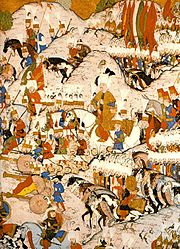
முதலாம் சுலைமான்(1520-1566) 1521இல் பெல்கிரேட் நகரைக் கைப்பற்றினார், ஹங்கேரி பேரரசின் மத்திய மற்றும் வட பகுதிகள் உதுமானிய-ஹங்கேரி போரில் வெற்றி கொள்ளப்பட்டன.[9] 1526இல் வரலாற்று முக்கியத்துவம் மிக்க முஹாக்ஸ் போரில் வெற்றி பெற்ற பின்னர் இன்றைய ஹங்கேரி (மேற்குப் பகுதி தவிர்ந்த) ஏனைய மத்திய ஐரோப்பா நிலப்பகுதிகளில் உதுமானிய ஆட்சி நிறுவப்பட்டது.
முதலாம் சுலைமானின் ஆட்சியின் இறுதிப்பகுதியில் பேரரசின் மொத்த மக்கள்தொகை ஏறத்தாழ ஒன்றரை கோடி பேர் என்றாகி மூன்று கண்டங்களுக்கும் மேலாக பரந்து காணப்பட்டதுடன் பேரரசின் சக்தி வாய்ந்த கடற்படை ஒன்று மத்திய தரைக்கடலின் பல பகுதிகளை தன் கட்டுப்பாட்டுக்குள் வைத்திருந்தது.[10]
தேக்கமும் சீர்திருத்தமும் (1566–1827)[தொகு]
1566க்குப் பிறகு பேரரசு தேக்கநிலையில் வீழ்ச்சியடையத் தொடங்கியதாக ஸ்டீபன் லீ கூறுகிறார். இடையிடையே சில காலங்களில் மீண்டு வருவதும் சீர்திருத்தமும் நிகழ்ந்து வந்தன. இந்த வீழ்ச்சி விரைவு பெற்று 1699இல் மிகக் கடுமையான நிலையை அடைந்தது.[11] பல வரலாற்றாளர்கள் இக்கூற்றை மறுத்தாலும் பலரும் "மோசமான சுல்தான்கள், திறமையற்ற முதலமைச்சர்கள், வலுவற்ற போர்க் கருவிகள்' பற்றாத படைகள், ஊழல் அலுவலர்கள், பேராசை பிடித்த முதலீட்டாளர்கள், வலுவான எதிரிகள், துரோகமிழைத்த நண்பர்கள்" ஆகிய காரணிகள் ஒத்தமான் பேரரசின் வீழ்ச்சிக்கு வழிவகுத்ததாகக் கூறுகின்றனர்.[12] தலைமையின் தோல்வியே முதன்மையான காரணம் எனக் கூறும் லீ 1292 முதல் 1566 வரை ஆண்ட பத்து சுல்தான்களில் ஒருவரைத் தவிர அனைவரும் மிகுந்த திறமை உள்ளவர்களாக இருந்தனர் என்கிறார். 1566 முதல் 1703 வரை ஆண்ட 13 சுல்தான்கள் இருவரைத் தவிர மற்றோர் ஈடுபாடின்றியும் திறமையின்றியும் இருந்தனர் என்கிறார் இவர்.[13] மிகவும் மையப்படுத்தப்பட்ட அமைப்பில் மைய அரசின் தோல்வி வீழ்ச்சிக்கு காரணமாக அமைந்தது. இதன் நேரடி விளைவாக மாகாண பிரபுக்கள் வலுபெற்று கான்ஸ்டாண்டிநோபிளை தவிர்க்கத் தொடங்கினர். ஐரோப்பிய எதிரிகளும் வலுபெற்று வந்தனர். உதுமானியப் படைகள் மேம்படுத்தப்படாமல் இருந்தன.[14][15] இறுதியாக உதுமானியப் பொருளாதாரம் சீர் குலைந்தது. போர் விளைவாக ஏற்பட்ட பணவீக்கம், உலக வணிகத்தின் திசை மாற்றங்கள், சட்டம் ஒழுங்குப் பிரச்சினைகள் போன்றவை பொருளாதார முன்னேற்றத்திற்கு தடையாக இருந்தன.[16]
வீழ்ச்சியும் நவீனமயமாக்கலும் (1828–1908)[தொகு]

டான்சிமாத் காலத்தில் (1839–1876) அரசு மேற்கொண்ட தொடர் சீர்திருத்தங்களால் படைகள் நவீனப்படுத்தப்பட்டன. வங்கி முறைமை மேம்படுத்தப்பட்டது. ஓரினச் சேர்க்கை குற்றமற்றதாக ஆக்கப்பட்டது. சமயச் சட்டங்களுக்கு மாற்றாக சமயச்சார்பற்ற சட்டங்கள் உருவாகின.[17] கலைஞர்களுக்கு நவீனத் தொழிலகங்கள் கட்டப்பட்டன. உதுமானிய அஞ்சல் அமைச்சகம் அக்டோபர் 23, 1840இல் நிறுவப்பட்டது.[18][19]
சாமுவெல் மோர்சுக்கு தந்தி கண்டுபிடித்ததற்காக 1847இல் ஆக்கவுரிமை வழங்கப்பட்டது.[20] இதனையடுத்து முதல் தந்தி தடம் இஸ்த்தான்புல் (கான்ஸ்டான்டினோப்பிள்) - அட்ரியனோப்பிள் - சும்னு இடையே அமைக்கப்பட்டது.[21] இந்தக் காலத்தின் உச்சமாக அரசியலமைப்புச் சட்டம் இயற்றப்பட்டது. ஆனால் அரசியலமைப்பு சார்ந்த அரசு இரண்டு ஆண்டுகளே நீடித்தது.
உயர்கல்வி பெற்றிருந்த பேரரசின் கிறித்தவக் குடிமக்கள், முஸ்லிம் பெரும்பான்மையை விட பொருளாதாரத்தில் முன்னேறியிருந்தனர். இது முஸ்லிம்களிடையே மனக்கசப்பை உருவாக்கியது.[22] 1861இல் உதுமானியக் கிறிஸ்தவர்களுக்கு 571 முதல்நிலை மற்றும் 94 இரண்டாம்நிலை பள்ளிகள் இருந்தன. இவற்றில் 140,000 மாணவர்கள் படித்தனர்.[22][22] 1911இல் இஸ்தான்புல்லில் இருந்த 654 மொத்த விற்பனை நிறுவனங்களில் 528 கிரேக்க இனத்தவர்களுக்கு உரிமையாக இருந்தன.[22]

பலமிழந்து வந்த உதுமானியப் பேரரசின் ஆட்சிக்குட்பட்ட பகுதிகளில் தங்களது தாக்கத்தை நிலைநிறுத்த ஐரோப்பிய அரசுகள் நடத்திய நீண்ட போராட்டத்தின் ஓர் அங்கமே கிரீமியப் போர் (1853–1856) ஆகும். இந்தப் போரினால் ஏற்பட்ட நிதி நெருக்கடியால் ஆகஸ்டு 4, 1854இல் உதுமானியப் பேரரசு 5 மில்லியன் பவுண்டுகளை வெளிநாடுகளிலிருந்து கடனாகப் பெற்றது.[23][24] மேலும் இப்போரின் விளைவாக 200,000 கிரீமிய டாடார்கள் உதுமானியப் பேரரசிற்குள் குடி புகுந்தனர்.[25] காக்கேசியப் போர்களின் இறுதியில் 90 விழுக்காடு காக்கேசியர்கள் இனப்படுகொலை செய்யப்பட்டனர்.[26] இதனால் காக்கேசியாவின் வடக்கில் தங்கள் வசிப்பிடங்களிலிருந்து வெளியேறிய இவர்கள் உதுமானியப் பேரரசில் தஞ்சம் புகுந்தனர்.[27][28][29] சில மதிப்பீடுகளின்படி மொத்தமாக பதினைந்து லட்சம் பேர் வெளியேற்றப்பட்டனர் அல்லது கொல்லப்பட்டனர்.[30]

1876இல் பல்கேரிய எழுச்சியின்போது 100000 பேர் கொல்லப்பட்ட பாசி-பசூக்.[31] 1877-78இல் நடந்த ரஷ்ய-துருக்கிப் போரில் ரஷ்யா வென்றது. இதன் விளைவாக உதுமானியப் பேரரசு ஐரோப்பிய நிலப்பகுதிகளை இழந்தது. பல்கேரியா உதுமானியப் பேரரசில் தன்னாட்சி பெற்ற குறுமன்னராட்சியாக நிறுவப்பட்டது. ரோமானியாவிற்கு முழு விடுதலை வழங்கப்பட்டது. செர்பியாவும் மொண்டெனேகுரோவும் விடுதலை பெற்றன. 1878இல் ஆஸ்திரியா-ஹங்கேரி தன்னிச்சையாக உதுமானியப் பேரரசின் மாகாணங்களான பொஸ்னிய-எர்செகொவினாவையும் நோவி பாசரையும் கையகப்படுத்தியது. இதை உதுமானிய அரசு எதிர்த்தபோதும் அதன் படைகள் மூன்றே வாரத்தில் தோற்றன.
பெர்லின் பேராயத்தில் பால்கன் தீபகற்பத்தில் உதுமானியப் பேரரசின் நிலப்பகுதிகள் மீட்கப்பட பிரித்தானியப் பிரதமர் பெஞ்சமின் டிஸ்ரைலி உதவினார். இதற்கு எதிர் உதவியாக பிரித்தானியாவிற்கு சைப்ரஸ் வழங்கப்பட்டது.[32] உராபிக் கலவரத்தை அடக்க உதுமானியாவிற்கு உதவுவதாகக் கூறி 1882இல் எகிப்திற்கு படைகளை அனுப்பிய பிரித்தானியா அப்பகுதியின் கட்டுப்பாட்டையும் பெற்றது.
1894 முதல் 1896 வரை நடைபெற்ற அமீதியப் படுகொலைகளில் 3 லட்சம் வரையிலான ஆர்மீனியர்கள் கொல்லப்பட்டனர்.[33]
இவ்வாறு சுருங்கிய உதுமானியப் பேரரசில் ஃபால்கனிய முஸ்லிம்கள் ஃபால்கன் அல்லது அனடோலியா பகுதிகளுக்கு இடம் பெயர்ந்தனர்.[34] 1923இல் அனடோலியா மற்றும் கிழக்கு திராஸ் ஆகியவை மட்டுமே முஸ்லிம் பகுதிகளாக இருந்தன.[35]
தோல்வியும் கலைப்பும் (1908–1922)[தொகு]

சனஜூலை 3, 1908இல் இளந்துருக்கியர் புரட்சிக்குப் பிறகு இரண்டாம் முறை அரசியலமைப்பு சார்ந்த அரசை நிறுவ முயற்சிகள் மேற்கொள்ளப்பட்டன. 1876ஆம் ஆண்டு அரசியலமைப்புச் சட்டமும் நாடாளுமன்றமும் திருத்தி அமைக்கப்படும் என சுல்தான் அறிவித்தார். அடுத்த ஆறு ஆண்டுகளுக்கு அரசியல் மற்றும் படைத்துறை சீர்திருத்தங்கள் மேற்கொள்ளப்பட்டன. இதுவே உதுமானியப் பேரரசு கலைக்கப்பட துவக்கமாகவும் அமைந்தது.
குடிமக்களின் சிக்கல்களுக்கிடையே ஆஸ்திரியா-ஹங்கேரி 1908இல் பொஸ்னியா எர்செகோவினாவைக் கைப்பற்றியது. ஆனால் போரைத் தவிர்க்க ஆக்கிரமித்திருந்த நோவி பசாரிலிருந்து தனது படைகளை பின்வாங்கிக் கொண்டது. இத்தாலி-துருக்கியப் போரின் போது (1911–12) உதுமானியா லிபியாவை இழந்தது. ஃபால்கன் சங்க நாடுகள் உதுமானியா மீது போர் தொடுத்தன. இந்தப் போர்களில் (1912–13) உதுமானியப் பேரரசு தோற்றது. இதன் விளைவாக கிழக்கு திராஸ் தவிர பால்கன் நிலப்பகுதிகளை இழந்தது உதுமானியப் பேரரசு. வரலாற்றுச் சிறப்புமிகு உதுமானியத் தலைநகரமான எடிர்னேயையும் இழந்தது. மதம் சார்ந்த கலவரங்களுக்கு அஞ்சி ஏறத்தாழ 4 லட்சம் முஸ்லிம்கள் தற்காலத் துருக்கிக்கு இடம் பெயர்ந்தனர். இவர்களில் பலர் வாந்திபேதி கொள்ளைநோயால் பயணத்தின்போதே இறந்தனர்.[36] 1821 முதல் 1922 வரை ஃபால்கன் நாடுகளில் நடைபெற்ற முஸ்லிம் இன அழிப்பில் பல லட்சம் முஸ்லிம்கள் கொல்லப்பட்டனர். பலர் வெளியேற்றப்பட்டனர்.[37][38][39] 1914 வாக்கில் பெரும்பாலான ஐரோப்பாவிலிருந்தும் வடக்கு ஆபிரிக்காவிலிருந்தும் உதுமானியப் பேரரசு துரத்தப்பட்டது. இருப்பினும் பேரரசின் ஆட்சியில் ஒன்றரை கோடி மக்கள் தற்கால துருக்கியிலும் 45 லட்சம் மக்கள் சிரியா, பாலஸ்தீனம் மற்றும் ஜோர்டானிலும் 25 லட்சம் மக்கள் ஈராக்கிலுமாக வாழ்ந்திருந்தனர். இது தவிர 55 லட்சம் மக்கள் அராபியத் தீபகற்பத்தில் உதுமானியப் பேரரசின் கட்டுப்பாட்டில் இருந்தனர்.[40]
நவம்பர் 1914இல் மைய சக்திகள் தரப்பில் உதுமானியப் பேரரசு முதல் உலகப் போரில் பங்கேற்றது. போரின் துவக்கத்தில் உதுமானியப் பேரரசுக்கு கலிப்பொலி போர்த்தொடர் போன்ற குறிப்பிடத்தக்க வெற்றிகள் கிடைத்தபோதும் ரஷ்யாவிற்கு எதிராக காக்கஸ் போரில் தோல்வியடைந்தது. உதுமானியப் பேரரசுக்கு எதிராக ஐக்கிய அமெரிக்க நாடுகள் போர் அறிவிக்கவில்லை.[41]

1915இல் ரஷ்யப் படைகள் பழைய ஆர்மீனியாவினுள் நுழைந்தன.[42] இதற்கு ஆர்மீனியர்கள் ஒத்துழைப்பு நல்கியதால் உதுமானியப் பேரரசு ஆர்மீனியர்களை வெளியேற்றவும் கொல்லவும் முற்பட்டது. இது ஆர்மீனிய இனப்படுகொலை என அறியப்படுகின்றது.[43] கிரேக்க, அசிரிய சிறுபான்மையினர் மீதும் இனப்படுகொலை நிகழ்வுகள் நடந்தேறின.[44]
1916இல் ஏற்பட்ட அரபுப் புரட்சி மத்திய கிழக்கில் உதுமானியப் பேரரசுக்கு எதிராக மாறியது. இறுதி உடன்பாட்டின்படி உதுமானியப் பேரரசு பிரிக்கப்பட்டது. 19ஆம் நூற்றாண்டின் இறுதியிலும் இருபதாம் நூற்றாண்டின் துவக்கத்திலும் 90 லட்சம் துருக்கிய-முஸ்லிம் அகதிகள் காக்கேசியா, கிரீமியா, பால்கன் குடா, நடுநிலக் கடல் தீவுகளிலிருந்து அனத்தோலியாவுக்கும் கிழக்கு திராசிற்கும் இடம் பெயர்ந்தனர்.[45]
கான்ஸ்டான்டிநோப்பிளின் முற்றுகையும் இஸ்மீர் முற்றுகையும் துருக்கிய தேசிய இயக்கத்தை முன்னிலைப்படுத்தியது. முஸ்தபா கமால் தலைமையில் இவ்வியக்கம் துருக்கிய விடுதலைப் போரை (1919–22) வென்றது. 1918 முதல் 1922 வரை ஆண்டுவந்த கடைசி சுல்தான் ஆறாம் முகம்மது நாட்டை விட்டு நவம்பர் 17, 1922இல் வெளியேறினார். துருக்கி தேசியப் பேரவை அக்டோபர் 29, 1923இல் துருக்கி குடியரசை நிறுவியது. மார்ச் 3, 1924இல் கலீஃபகமும் கலைக்கப்பட்டது.[46]
உதுமானிய சுல்தான்கள் பட்டியல்[தொகு]
| No. | சுல்தான் | படம் | ஆட்சிக்காலம் | துக்ரா | நாணயம் |
|---|---|---|---|---|---|
| 1 | முதலாம் உதுமான் | 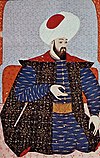
|
அண். 1299 – c. 1324[47] | 
| |
| 2. | ஓர்கான் | 
|
அண். 1324 – மார்ச் 1362 | 
|

|
| 3. | முதலாம் முராத்[b] | 
|
மார்ச் 1362 – 15 சூன் 1389 | 
|

|
| 4 | முதலாம் பேய்சித்து | 
|
15 சூன் 1389 – 20 சூலை 1402 |  | |
|
|
| 5 | முதலாம் மெஹ்மத்து | 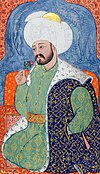
|
5 சூலை 1413 – 26 மே 1421 | 
|
|
| 6 | இரண்டாம் முராத் | 
|
25 சூன் 1421 - ஆகத்து 1444 | 
|
 
|
| 7 | இரண்டாம் மெஹ்மத்து | 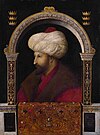
|
ஆகத்து 1444 – செப்டம்பர் 1446 | 
|

|
| (6) | இரண்டாம் முராத் | 
|
செப்டம்பர் 1446 –
3 பிப்ரவரி 1451 (4 years, 5 months) |

|
|
| (7) | இரண்டாம் மெஹ்மத்து | 
|
3 பிப்ரவரி 1451 – 3 மே 1481
(30 ஆண்டுகள், 89 நாட்கள்) |

|

|
| 8 | இரண்டாம் பேய்சித்து | 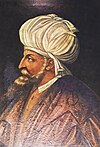
|
19 மே 1481 – 25 ஏப்ரல் 1512
(30 ஆண்டுகள், 342 நாட்கள்) |

|

|
| — | சீம் சுல்தான் | 
|
28 மே – 20 சூன் 1481
(0 ஆண்டுகள், 23 நாட்கள்) |

|

|
| 9 | முதலாம் சீலிம் | 
|
25 ஏப்ரல் 1512 –
21 செப்டம்பர் 1520 (8 ஆண்டுகள், 149 நாட்கள்) |

| |
| 10 | முதலாம் சுலைமான் | 
|
30 செப்டம்பர் 1520 – 6 செப்டம்பர் 1566
(45 ஆண்டுகள், 341 நாட்கள்) |

|

|
| 11 | இரண்டாம் சீலிம் | 
|
29 செப்டம்பர் 1566 – 15 டிசம்பர் 1574
(8 ஆண்டுகள், 77 நாட்கள்) |
 
| |
| 12 | மூன்றாம் முராத் | 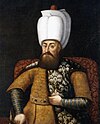
|
27 டிசம்பர் 1574 – 16 சனவரி 1595
(20 ஆண்டுகள், 20 நாட்கள்) |

|

|
| 13 | மூன்றாம் மெஹ்மத்து | 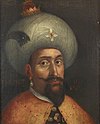
|
16 சனவரி 1595 – 22 டிசம்பர் 1603
(8 ஆண்டுகள், 340 நாட்கள்) |

|

|
| 14 | முதலாம் அகமது | 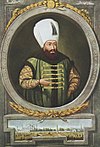
|
22 டிசம்பர் 1603 – 22 நவம்பர் 1617
(13 ஆண்டுகள், 335 நாட்கள்) |

|

|
| 15 | முதலாம் முசுதபா | 
|
22 நவம்பர் 1617 –
26 பிப்ரவரி 1618 (0 ஆண்டுகள், 96 நாட்கள்) |
||
| 16 | இரண்டாம் உதுமான் | 
|
26 பிப்ரவரி 1618 –
19 மே 1622 (4 ஆண்டுகள், 82 நாட்கள்) |

| |
| (15) | முதலாம் முசுதபா | 
|
20 மே 1622 –
10 செப்டம்பர் 1623 (1 ஆண்டு, 113 நாட்கள்) |
||
| 17 | நான்காம் முராத் | 
|
10 செப்டம்பர் 1623 –
8 பிப்ரவரி 1640 (16 ஆண்டுகள், 151 நாட்கள்) |

|
|
| 18 | இப்ராகிம் | 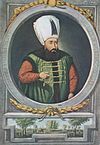
|
9 பிப்ரவரி 1640 –
8 ஆகத்து 1648 (8 ஆண்டுகள், 181 நாட்கள்) |

|
|
| 19 | நான்காம் மெஹ்மத்து | 
|
8 ஆகத்து 1648 –
8 நவம்பர் 1687 (39 ஆண்டுகள், 92 நாட்கள்) |

|
|
| 20 | இரண்டாம் சுலைமான் | 
|
8 நவம்பர் 1687 –
22 சூன் 1691 (3 ஆண்டுகள், 226 நாட்கள்) |

| |
| 21 | இரண்டாம் அகமது | 
|
22 சூன் 1691 –
6 பிப்ரவரி 1695 (3 ஆண்டுகள், 229 நாட்கள்) |

|
|
| 22 | இரண்டாம் முசுதபா | 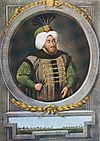
|
6 பிப்ரவரி 1695 –
22 ஆகத்து 1703 (8 ஆண்டுகள், 197 நாட்கள்) |

|
|
| 23 | மூன்றாம் அகமது | 
|
22 ஆகத்து 1703 –
1 அக்டோபர் 1730 (27 ஆண்டுகள், 40 நாட்கள்) |

|

|
| 24 | முதலாம் மஹ்மூத்து | 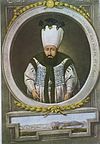
|
2 அக்டோபர் 1730 –
13 டிசம்பர் 1754 (24 ஆண்டுகள், 72 நாட்கள்) |

|

|
| 25 | மூன்றாம் உதுமான் | 
|
13 டிசம்பர் 1754 –
30 அக்டோபர் 1757 (2 ஆண்டுகள், 321 நாட்கள்) |

| |
| 26 | முதலாம் முசுதபா | 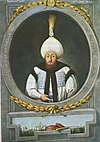
|
30 அக்டோபர் 1757 –
21 சனவரி 1774 (16 ஆண்டுகள், 83 நாட்கள்) |

|
 
|
| 27 | முதலாம் அப்துல் அமீது | 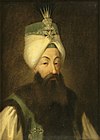
|
21 சனவரி 1774 –
7 ஏப்ரல் 1789 (15 ஆண்டுகள், 76 நாட்கள்) |

|

|
| 28 | மூன்றாம் சீலிம் | 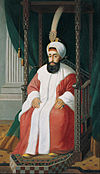
|
7 ஏப்ரல் 1789 –
29 மே 1807 (18 ஆண்டுகள், 52 நாட்கள்) |

|

|
| 29 | நான்காம் முசுதபா | 
|
29 மே 1807 –
28 சூலை 1808 (1 ஆண்டு, 60 நாட்கள்) |

|
|
| 30 | இரண்டாம் மஹ்மூத்து | 
|
28 சூலை 1808 –
1 சூலை 1839 (30 ஆண்டுகள், 338 நாட்கள்) |

|
 
|
| 31 | முதலாம் அப்துல் மெஜித்து | 
|
1 சூலை 1839 –
25 சூன் 1861 (21 ஆண்டுகள், 359 நாட்கள்) |

|
 
|
| 32 | அப்துல் அஜிசு | 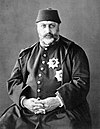
|
25 சூன் 1861 –
30 மே 1876 (14 ஆண்டுகள், 340 நாட்கள்) |

|
 
|
| 33 | ஐந்தாம் முராத் | 
|
30 மே – 31 ஆகத்து 1876
(0 ஆண்டுகள், 93 நாட்கள்) |

|
|
| 34 | இரண்டாம் அப்துல் அமீத்து | 
|
31 ஆகத்து 1876 –
27 ஏப்ரல் 1909 (32 ஆண்டுகள், 239 நாட்கள்) |

|

|
| 35 | ஐந்தாம் மெஹ்மத்து | 
|
27 ஏப்ரல் 1909 –
3 சூலை 1918 (9 ஆண்டுகள், 67 நாட்கள்) |

|

|
| 36 | ஆறாம் மெஹ்மத்து | 
|
4 சூலை 1918 –
1 நவம்பர் 1922 (4 ஆண்டுகள், 120 நாட்கள்) |

|

|
| — | இரண்டாம் அப்துல் மெஜித்து | 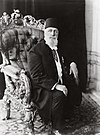
|
18 நவம்பர் 1922 –
3 மார்ச் 1924 (1 ஆண்டு, 106 நாட்கள்) |
— | — |
மேற்கோள்கள்[தொகு]
- ↑ The A to Z of the Ottoman Empire, by Selcuk Aksin Somel, 2010, p.179
- ↑ The Ottoman Empire, 1700-1922, Donald Quataert, 2005, p.4
- ↑ The Grove Encyclopedia of Islamic Art and Architecture: Delhi to Mosque, Jonathan M. Bloom, Sheila Blair, 2009. p.82
- ↑ "The Sultans: Osman Gazi". TheOttomans.org. பார்க்கப்பட்ட நாள் 13 December 2010.
- ↑ Stone, Norman (2005). "Turkey in the Russian Mirror". in Mark Erickson, Ljubica Erickson. Russia War, Peace And Diplomacy: Essays in Honour of John Erickson. Weidenfeld & Nicolson. பக். 94. பன்னாட்டுத் தரப்புத்தக எண்:978-0-297-84913-1. http://books.google.com/books?id=xM9wQgAACAAJ. பார்த்த நாள்: 11 February 2013.
- ↑ Karpat, Kemal H. (1974). The Ottoman state and its place in world history. Leiden: Brill. பக். 111. பன்னாட்டுத் தரப்புத்தக எண்:90-04-03945-7.
- ↑ Savory, R. M. (1960). "The Principal Offices of the Ṣafawid State during the Reign of Ismā'īl I (907-30/1501-24)". Bulletin of the School of Oriental and African Studies, University of London 23 (1): 91–105. doi:10.1017/S0041977X00149006.
- ↑ Hess, Andrew C. (January 1973). "The Ottoman Conquest of Egypt (1517) and the Beginning of the Sixteenth-Century World War". International Journal of Middle East Studies 4 (1): 55–76. doi:10.1017/S0020743800027276. https://archive.org/details/sim_international-journal-of-middle-east-studies_1973-01_4_1/page/55.
- ↑ "Origins of the Magyars". Hungary. Britannica Online Encyclopedia. பார்க்கப்பட்ட நாள் 26 August 2010.
- ↑ Mansel, Philip (1997). Constantinople : city of the world's desire 1453-1924. London: Penguin. பக். 61. பன்னாட்டுத் தரப்புத்தக எண்:0140262466.
- ↑ Stephen J. Lee, Aspects of European History: 1494-1789 (2nd ed., 1984) p 77
- ↑ Joel Shinder, "Career Line Formation in the Ottoman Bureaucracy, 1648-1750: A New Perspective," Journal of the Economic & Social History of the Orient (1973) 16#2 pp 217-237; Shindler is a dissenter.
- ↑ Lee, Aspects of European History: 1494-1789 (1984) pp 77-84
- ↑ David Nicolle, Armies of the Ottoman Turks 1300-1774 (Osprey, 1983)
- ↑ Jonathan Grant, "Rethinking The Ottoman "Decline": Military Technology Diffusion in the Ottoman Empire, Fifteenth to Eighteenth Centuries," Journal of World History (1999) 10#1 pp 179-201.
- ↑ On the economic troubles see Hakan Berument and Asli Gunay 1. "Inflation Dynamics and its Sources in the Ottoman Empire: 1586–1913." International Review of Applied Economics (2007) 21#2 pp: 207-245. online
- ↑ Ishtiaq, Hussain. "The Tanzimat: Secular reforms in the Ottoman Empire" (PDF). Faith Matters.
- ↑ "PTT Chronology" (in Turkish). PTT Genel Müdürlüğü. 13 September 2008. Archived from the original on 13 செப்டம்பர் 2008. பார்க்கப்பட்ட நாள் 11 February 2013.
{{cite web}}: Check date values in:|archivedate=(help)CS1 maint: unrecognized language (link) - ↑ "History of the Turkish Postal Service". Ptt.gov.tr. Archived from the original on 1 ஏப்ரல் 2013. பார்க்கப்பட்ட நாள் 6 November 2011.
{{cite web}}: Check date values in:|archive-date=(help) - ↑ "Beylerbeyi Palace". Istanbul City Guide. Archived from the original on 10 அக்டோபர் 2007. பார்க்கப்பட்ட நாள் 11 February 2013.
- ↑ (in Turkish) Sultan Abdülmecid: İlklerin Padişahı. NTV Tarih. p. 49. http://www.ntvtarih.com.tr/. பார்த்த நாள்: 11 February 2013.
- ↑ 22.0 22.1 22.2 22.3 Stone, Norman (2005). "Turkey in the Russian Mirror". in Mark Erickson, Ljubica Erickson. Russia War, Peace And Diplomacy: Essays in Honour of John Erickson. Weidenfeld & Nicolson. பக். 95. பன்னாட்டுத் தரப்புத்தக எண்:978-0-297-84913-1. http://books.google.com/books?id=xM9wQgAACAAJ. பார்த்த நாள்: 11 February 2013.
- ↑ V. Necla Geyikdagi (15 March 2011). Foreign Investment in the Ottoman Empire: International Trade and Relations 1854–1914. I.B.Tauris. பக். 32. பன்னாட்டுத் தரப்புத்தக எண்:978-1-84885-461-1. http://books.google.com/books?id=fGRMOzJZ4aEC&pg=PA32. பார்த்த நாள்: 12 February 2013.
- ↑ Douglas Arthur Howard (2001). The History of Turkey. Greenwood Publishing Group. பக். 71. பன்னாட்டுத் தரப்புத்தக எண்:978-0-313-30708-9. http://books.google.com/books?id=Ay-IkMqrTp4C&pg=PA71. பார்த்த நாள்: 11 February 2013.
- ↑ Williams, Bryan Glynn (2000). "Hijra and forced migration from nineteenth-century Russia to the Ottoman Empire". Cahiers du Monde russe 41 (1): 79–108. doi:10.4000/monderusse.39. http://monderusse.revues.org/39.
- ↑ Memoirs of Miliutin, "the plan of action decided upon for 1860 was to cleanse [ochistit'] the mountain zone of its indigenous population", per Richmond, W. The Northwest Caucasus: Past, Present, and Future. Routledge. 2008.
- ↑ Richmond, Walter (29 July 2008). The Northwest Caucasus: Past, Present, Future. Taylor & Francis US. பக். 79. பன்னாட்டுத் தரப்புத்தக எண்:978-0-415-77615-8. http://books.google.com/books?id=LQJyLvMWB8MC&pg=PA79. பார்த்த நாள்: 11 February 2013. "the plan of action decided upon for 1860 was to cleanse [ochistit'] the mountain zone of its indigenous population"
- ↑ Charlotte Mathilde Louise Hille (2010). State building and conflict resolution in the Caucasus. BRILL. பக். 50. பன்னாட்டுத் தரப்புத்தக எண்:978-90-04-17901-1. http://books.google.com/books?id=yxFP6K8iZzQC&pg=PA50. பார்த்த நாள்: 4 May 2013.
- ↑ Daniel Chirot; Clark McCauley (1 July 2010). Why Not Kill Them All?: The Logic and Prevention of Mass Political Murder (New in Paper). Princeton University Press. பக். 23. பன்னாட்டுத் தரப்புத்தக எண்:978-1-4008-3485-3. http://books.google.com/books?id=9sPJnd0cwV0C&pg=PA23. பார்த்த நாள்: 4 May 2013.
- ↑ "145th Anniversary of the Circassian Genocide and the Sochi Olympics Issue". Reuters. 22 May 2009 இம் மூலத்தில் இருந்து 2 ஜூலை 2012 அன்று. பரணிடப்பட்டது.. https://web.archive.org/web/20120702174523/http://www.reuters.com/article/2009/05/22/idUS104971+22-May-2009+PRN20090522. பார்த்த நாள்: 28 November 2009.
- ↑ Jelavich, Charles; Jelavich, Barbara (1986). The Establishment of the Balkan National States, 1804–1920. பக். 139. பன்னாட்டுத் தரப்புத்தக எண்:9780295803609. http://books.google.com/?id=LBYriPYyfUoC&pg=PA139&dq=massacre+bulgarians++1876#v=onepage&q&f=false..
- ↑ A. J. P. Taylor (1955). The Struggle for Mastery in Europe, 1848–1918. Oxford: Oxford University Press. பக். 228–54. பன்னாட்டுத் தரப்புத்தக எண்:978-0-19-822101-2.
- ↑ Taner Akçam (2006). A Shameful Act: The Armenian Genocide and the Question of Turkish Responsibility. New York: Metropolitan Books. பக். 42. பன்னாட்டுத் தரப்புத்தக எண்:0-8050-7932-7. https://archive.org/details/shamefulactarmen0000akam.
- ↑ Mann, Michael (1 November 2004). The Dark Side of Democracy: Explaining Ethnic Cleansing. Cambridge University Press. பக். 118. பன்னாட்டுத் தரப்புத்தக எண்:978-0-521-53854-1. http://books.google.com/books?id=cGHGPgj1_tIC&pg=PA118. பார்த்த நாள்: 11 February 2013.
- ↑ Matthew J. Gibney; Randall A. Hansen (30 June 2005). Immigration and Asylum: From 1900 to the Present. ABC-CLIO. பக். 437. பன்னாட்டுத் தரப்புத்தக எண்:978-1-57607-796-2. http://books.google.com/books?id=2c6ifbjx2wMC. பார்த்த நாள்: 11 February 2013. "Muslims had been the majority in Anatolia, the Crimea, the Balkans and the Caucasus and a plurality in southern Russia and sections of Romania. Most of these lands were within or contiguous with the Ottoman Empire. By 1923, only Anatolia, eastern Thrace and a section of the south-eastern Caucasus remained to the Muslim land."[தொடர்பிழந்த இணைப்பு]
- ↑ (PDF) Greek and Turkish refugees and deportees 1912–1924. NL: Universiteit Leiden. p. 1 இம் மூலத்தில் இருந்து 16 ஜூலை 2007 அன்று. பரணிடப்பட்டது.. https://web.archive.org/web/20070716155929/http://tulp.leidenuniv.nl/content_docs/wap/ejz18.pdf. பார்த்த நாள்: 5 டிசம்பர் 2014.
- ↑ Justin McCarthy (1995). Death and exile: the ethnic cleansing of Ottoman Muslims, 1821–1922. Darwin Press. பன்னாட்டுத் தரப்புத்தக எண்:978-0-87850-094-9. http://books.google.com/books?id=1ZntAAAAMAAJ. பார்த்த நாள்: 1 May 2013.
- ↑ Cathie Carmichael (12 November 2012). Ethnic Cleansing in the Balkans: Nationalism and the Destruction of Tradition. Routledge. பன்னாட்டுத் தரப்புத்தக எண்:978-1-134-47953-5. http://books.google.com/books?id=ybORI4KWwdIC. பார்த்த நாள்: 1 May 2013.
"During the period from 1821 to 1922 alone, Justin McCarthy estimates that the ethnic cleansing of Ottoman Muslims led to the death of several million individuals and the expulsion of a similar number." - ↑ Oxford University Press (1 May 2010). Islam in the Balkans: Oxford Bibliographies Online Research Guide. Oxford University Press. பக். 9–. பன்னாட்டுத் தரப்புத்தக எண்:978-0-19-980381-1. http://books.google.com/books?id=Kck_-B7MubIC&pg=PA9. பார்த்த நாள்: 1 May 2013.
- ↑ Şevket Pamuk (2009). "The Ottoman Economy in World War I". in Broadberry/Harrison. The Economics of World War I. Cambridge University Press. பக். 112. பன்னாட்டுத் தரப்புத்தக எண்:978-1-139-44835-2. http://books.google.com/books?id=rpBbX3kdnhgC&pg=PA112. பார்த்த நாள்: 18 February 2013.
- ↑ Spencer C. Tucker, தொகுப்பாசிரியர் (2005). World War I: A – D.. ABC-CLIO. பக். 1080. பன்னாட்டுத் தரப்புத்தக எண்:978-1-85109-420-2. http://books.google.com/books?id=2YqjfHLyyj8C&pg=PA1080. பார்த்த நாள்: 15 February 2013.
- ↑ Encyclopædia Britannica. "Armenian massacres (Turkish-Armenian history)". Britannica Online Encyclopedia. பார்க்கப்பட்ட நாள் 26 August 2010.
- ↑ Peter Balakian (13 October 2009). The Burning Tigris. HarperCollins. பக். xvii. பன்னாட்டுத் தரப்புத்தக எண்:978-0-06-186017-1. http://books.google.com/books?id=DrYoyAM3PBYC&pg=PR17. பார்த்த நாள்: 8 June 2013.
- ↑ Schaller, Dominik J; Zimmerer, Jürgen (2008). "Late Ottoman genocides: the dissolution of the Ottoman Empire and Young Turkish population and extermination policies – introduction". Journal of Genocide Research 10 (1): 7–14. doi:10.1080/14623520801950820. http://bridging-the-divide.org/sites/default/files/files/Late%20Ottoman%20genocides-%20the%20dissolution%20of%20the%20Ottoman%20Empire%20and%20Young%20Turkish%20population%20and%20extermination%20policies%281%29.pdf. பார்த்த நாள்: 2014-12-05. "The genocidal quality of the murderous campaigns against Greeks and Assyrians is obvious"
- ↑ Kemal H Karpat (2004). Studies on Turkish politics and society: selected articles and essays. BRILL. பன்னாட்டுத் தரப்புத்தக எண்:978-90-04-13322-8. http://books.google.com/books?id=cL4Ua6gGyWUC. பார்த்த நாள்: 24 May 2013.[தொடர்பிழந்த இணைப்பு]
- ↑ Hakan Ozoglu (24 June 2011). From Caliphate to Secular State: Power Struggle in the Early Turkish Republic. ABC-CLIO. பக். 8. பன்னாட்டுத் தரப்புத்தக எண்:978-0-313-37957-4. http://books.google.com/books?id=Cw5V1c1ej_cC&pg=PA8. பார்த்த நாள்: 8 June 2013.
- ↑ Finkel 2007, p. 33.


